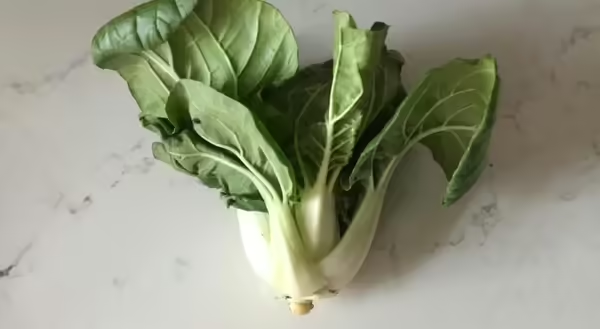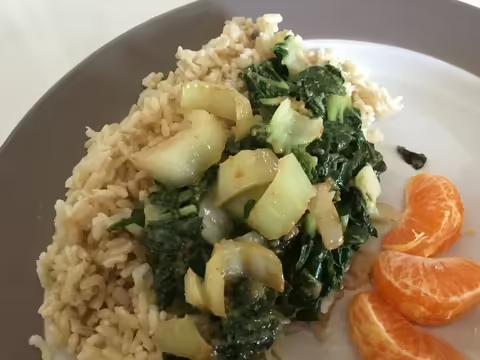
Cabbage comes in many more shapes than light green or dark purple globes. Bok choy – or pak choi – is one of the looser leaf styles of cabbage, and one of the foods in my CSA (community supported agriculture) share for late spring this year.
Like other cabbages, bok choy is a source of vitamins and minerals, including several B-vitamins, calcium, and iron. It does not have much in the way of macronutrients. In fact, 1 cup of shredded raw bok choy contains just 10 calories, 2g carbohydrates, 1g protein, and very little fat.
- Buy: Find both baby and full-sized bok choy at stores and local farms. Look for bok choy that have firm, bright green leaves and a firm, white stem. Do not buy those with limp or discolored leaves.
- Price: Bok choy prices will vary by store and local farms. Like other cabbages, even a small bok choy produces a lot of food once cut up.
- Store: Place bok choy in the refrigerator, unwashed, for best quality. Wrap loosely in a food-safe plastic bag, or add to a food-safe storage container big enough to fit the cabbage. For longer storage, try freezing bok choy.
- Prepare: Bok choy has many layers, which allows soil to find space between the leaves. Wash bok choy before preparing, paying attention to remove soil. Cut full-sized bok choy into bite-sized pieces or the size called for in your recipe. Baby bok choy can also be cut into small pieces, though some recipes may call for simply cutting the bok choy in half or into quarters.
- Eat: Bok choy has a very mild flavor on its own, making it a great candidate for recipes with lots of flavors, like garlic, ginger, and chilis. Bok choy work well as a stir-fry veggie or roasted in a hot oven. The white stems are crunchy with a subtle sweetness that would work well in coleslaw. The greens can be eaten raw too, but know they have a slight bitter taste.
Bok Choy in a Simple Peanut Sauce | Print recipe
(serves 1)
For a saucier recipe, double the sauce ingredients.
1 baby bok choy
1 Tbsp peanut butter
1 tsp oil
1 tsp flavored vinegar (I like red wine or balsamic for this recipe)
1/4 tsp garlic powder
1/4 tsp ground ginger
1/8 tsp ground cayenne pepper
1. Wash hands.
2. Wash bok choy and cut into bite-sized pieces, using both the green leaves and white stems. Place a small skillet over medium heat. Add cut bok choy and 1/4 cup water. Cook, stirring occasionally, for 5-10 minutes, or until leaves are tender.
3. In a small bowl, combine peanut butter, oil, vinegar, garlic, ginger, and cayenne pepper until smooth. Pour into skillet and stir to coat bok choy.
4. Serve hot over cooked brown rice, pair with a protein of your choice, and a side of fruit.
Nutritional analysis per serving (without rice, protein, or fruit): 140 calories, 13g total fat (3g saturated fat), 115mg sodium, 5g carbohydrate, 1g fiber, 4g protein
References:
- UF/IFAS Extension, Bok Choy, an Asian Leafy Green Vegetable Emerging in Florida, 2019
- North Carolina Cooperative Extension, Bring Home the Bok Choy, 2016
- University of Nebraska-Lincoln Extension, Bok Choy, N/D
- Purdue Extension, Food Link, Bok Choy, N/D
- USDA, Agricultural Research Service, National Nutrient Database for Standard Reference Release 27
Healthy Eats and Repeat
How much difference is there between canned and frozen foods? How should you cook venison? When is the best time to buy avocados? Get answers to these questions as well as other tips, tutorials and recipes for common kitchen foods and items with University of Illinois Extension Nutrition & Wellness Educator Caitlin Mellendorf’s blog Healthy Eats and Repeat. Build your best life. Trust Extension to help.
Caitlin Mellendorf is an Illinois Extension Nutrition and Wellness Educator serving DeWitt, Macon and Piatt Counties in Central Illinois. She is a Registered Dietitian and her work focuses on helping community members gain the knowledge, skills and tools to live healthier, more nutritious lifestyles. This includes providing programs and answering questions about heart health, diabetes, food safety, food preservation, grocery shopping and cooking. You can reach Caitlin by email at chuth2@illinois.edu or call 217.877.6042. Check out her nutrition blog Healthy Eats and Repeats for seasonal recipes and of an exploration of common kitchen foods.
